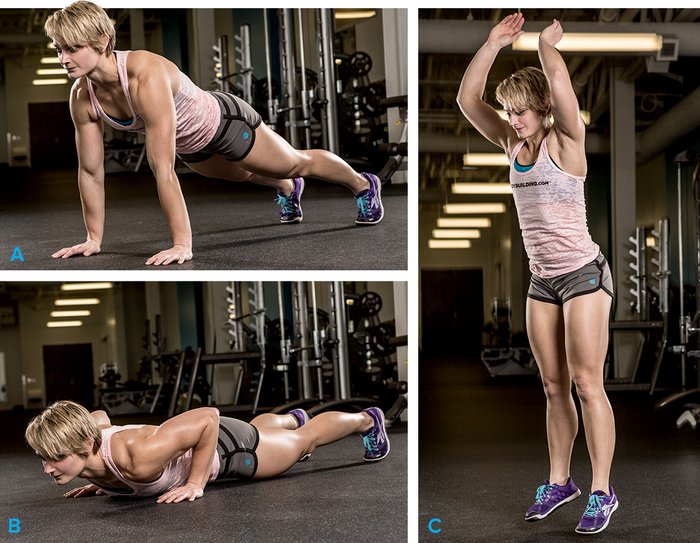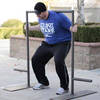Have you ever compared the physique of a world-class distance runner with that of a world-class sprinter? The sprinter's body resembles that of a Greek Adonis, with chiseled arms and powerful quads, while the skinny-fat distance runner makes Richard Simmons look like a Mr. Olympia contender.
These different body compositions point to the fact that not all cardio is created equal, which is why it's important to choose a form of cardio that meets your goals. A recent study compared participants who did steady-state cardio for 30 minutes three times a week to those who did 20 minutes of high-intensity interval training (HIIT) three times per week.
Both groups showed similar weight loss, but the HIIT group showed a 2 percent loss in body fat while the steady-state group lost only 0.3 percent. The HIIT group also gained nearly two pounds of muscle, while the steady-state group lost almost a pound.[1]
Excessive aerobic activity can decrease testosterone levels, increase cortisol production, weaken the immune system, handicap strength gains, and halt any hope of hypertrophy. But this doesn't mean you can't maximize muscle mass and strength gains while conditioning. It just means you need to be smart about your cardio.
Check out the different forms of conditioning you can use to trim down the smart way—without giving up your strength and muscle gains.
The Arrival Of Interval Training
Since the mid-1990s, scores of studies have shown the effectiveness of interval conditioning for fat loss. One Canadian study compared the fat-loss effects of interval training versus a traditional, slow cardio regimen.[2] The traditional regimen burned twice as many calories as the interval regimen, but those who performed intervals lost more body fat.

Since the mid-1990s, scores of studies have shown the effectiveness of interval conditioning for fat loss.
More recently, a study in the "Journal of Obesity" showed that 12 weeks of HIIT reduced body fat and increased muscle mass. There were also substantial reductions in total abdominal trunk and visceral fat, and increases in lean body mass and aerobic power. The most surprising aspect of the results was that the subjects' diets remained the same.
Since fat loss largely takes place in the kitchen, this is one more study touting the powerful effects of high-intensity interval training.
The Prevalence Of Tabata
Different forms of Tabata are practiced everywhere in the world, from plush, commercial gyms to sparse, hardcore, garage gyms.

Named after Japanese researcher Izumi Tabata, who has conducted extensive research on interval training, Tabata consists of performing an activity all-out for 20 seconds, resting for 10 seconds, and then repeating the on-off sequence for four minutes total.
One of Tabata's most famous findings demonstrated that 20 seconds of all-out cycling followed by 10 seconds of low intensity cycling for four minutes was as beneficial for VO2 max (maximal aerobic capacity) as 45 minutes of long, slow cardio performed four times per week.
Since VO2 max is generally considered the best indicator of an athlete's cardiovascular fitness and aerobic endurance, this study was a game changer.
It conclusively showed that positive health benefits derived from traditional aerobic training could be accomplished with high-intensity interval training.
What does this mean for you? You can stop spinning your wheels sooner if you trade in slow times on the treadmill for a fast sprint!
Interval Problems
Interval training is not without its downfalls, of course. Just because I'm suggesting it to build a lean, mean physique doesn't mean you should incorporate it into your routine on a daily basis. In fact, you shouldn't.
True interval training isn't a rushed jog—it's balls out. The central nervous system (CNS) is primarily affected by this high-intensity work and takes a minimum of 48 hours to recover. The late Canadian sprints coach Charlie Francis described the CNS like a cup of tea—everything pours into the cup until things start to overflow.
Overtraining leads to overflow. If you're overtraining, intervals can tax your CNS and cause muscle damage, mechanical tension, and metabolic stress. Like lifting heavy iron, interval training must be allotted sufficient recovery time.
Applied Interval Training
Training intervals once per week can improve body composition along with conditioning levels. If you're looking to really up your conditioning, twice a week is a nice, sweet spot.
Not sure where to start? Here are some of my favorite interval workouts. I use them with clients seeking fat loss and conditioning. And, of course, I use them myself.

Barbell Deadlift
1. Barbell Complexes
Barbell complexes have been around for decades. They make body fat run for the hills and can take your conditioning to new levels. They're easy to incorporate into strength-training workouts and can be done at the end for a great finisher. Barbell complexes can also be used to kick off your training, and are very easy to integrate with the corresponding workout in your split.
Barbell complexes should be included in your weekly interval workouts. Barbell complexes are not meant to be paced! Each rep is performed explosively, using whole-body movements. The objective of the complex is to get each group of exercises done as fast as possible. Never rest between exercises; only rest between complexes for 1-2 minutes.
Do as many complexes as possible in 8-10 minutes. Start with an empty bar and add weight in 5-pound increments.
Lower Body Complex
This is a good complex to try after leg day because it essentially serves as a finisher without stressing an unworked body part. All of the movements adhere to the barbell complex guidelines and are primarily lower-body movements.
Total-Body Complex
This workout looks similar to leg day, but the addition of the push press and the bent-over row makes it more of a whole-body workout.
Barbell Complex Progression
Barbell complexes challenge you mentally and physically. If they're not painful, you're sandbagging! Overload barbell complexes weekly, but in small increments.
Try adding a one-pound plate to the bar, increasing repetitions per set, or slightly decreasing rest intervals.
2. Strongman Intervals
Ever wonder why strongmen are much leaner than powerlifters? It ain't diet! If you have access to strongman equipment, use it! Go all-out for any of the combinations below and you'll learn firsthand why this method is so effective.

I love the first two combinations because they literally work every muscle in your body and they get your heart rate up quickly.
The third combination—crucifixes and log lifts—has more of a localized training effect. It'll have your shoulders screaming, and makes a great sequence to finish off a shoulder workout.
Limit sessions to no more than three days per week to avoid overtraining.
3. Burpees
If you're looking for something without weights, turn to burpees. Long before burpees were established as a jailhouse favorite, this exercise was a fitness test for the armed services in the World War II era.
Burpees build muscle, burn fat, and are one of the most effective conditioning modalities on the planet.
As with all of our conditioning workouts, we want to restrict burpees to less than 10 minutes in total duration.

Burpees
Total Repetition Method
Looking for a great way to push yourself? Select a target number of repetitions plan to hit that number in under 10 minutes. The number of repetitions in a set and the rest interval between sets are at your own discretion. If you miss your target, get it next time!
Tabata Burpee Training
Looking to ditch the weights and have a cardio-focused, fat-blasting session? Do as many burpees as possible in 20 seconds, rest for 10 seconds, and repeat this process for 4 minutes.
What About Walking?
Since intense interval training should be done sparingly and for short duration, walking should never really leave your conditioning portfolio. After all, interval training for over 30 minutes at more than 75 percent intensity can be detrimental to your gains.[3]
As a result, low-impact walking is a great activity to employ on your non-interval conditioning days. It increase heart health and helps your muscles and joints stay healthy. It even decreases stress.
You really only need to do a maximum of 30-45 minutes a day, but 15-20 minutes will do the job. Interval training paired with a few weekly walks will keep you lean and mean, and keep your ticker ticking.
References
- Sijie, T., Hainai, Y., Fengying, Y., & Jianxiong, W. (2012). High intensity interval exercise training in overweight young women. Journal of Sports Medicine and Physical Fitness,52(3), 255-62.
- Tremblay, A., Simoneau, J., & Bouchard, C. (1994). Impact Of Exercise Intensity On Body Fatness And Skeletal Muscle Metabolism. Metabolism, 43(7), 814-818.
- Wilson, J., Marin, P., Wilson, S., Loenneke, J., & Anderson, J. (2012). Concurrent Training: A Meta-Analysis Examining Interference of Aerobic and Resistance Exercises. Journal of Strength and Conditioning Research, 26(8), 2293-307.





























